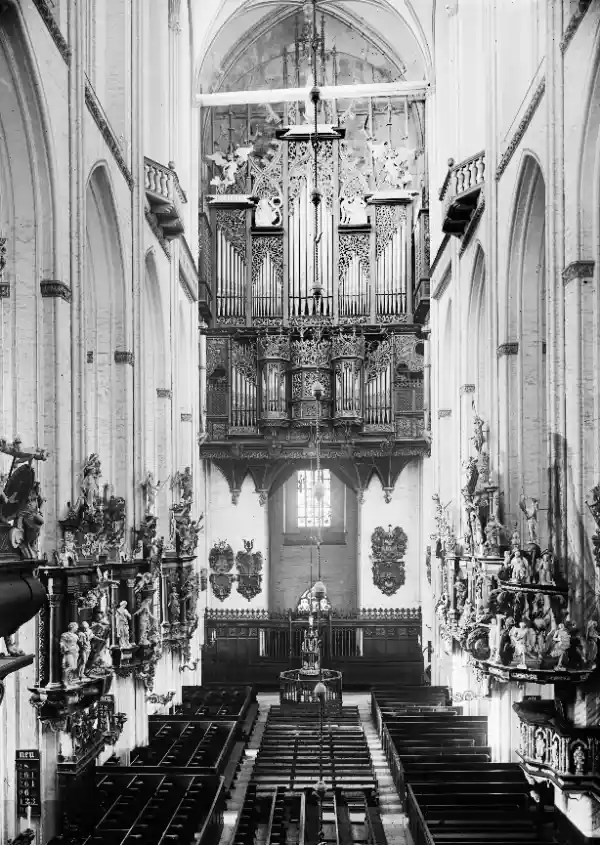Our Organs
Impressive sound for your ears
Organ music in St Marien has been one of the most important pillars of culture in our town since the 14th century.
Organs at St Marien
An impressive History
With the construction of the large organ by Barthold Hering - the huge Gothic facade adorned St Marien for over 400 years - and the extensions of the two organs by Friedrich Stellwagen, St Marien had representative and very high-quality instruments. They were the inspiration for the compositions and improvisations of the musicians at St Marien, of whom Franz Tunder and Dieterich Buxtehude in particular are known worldwide.
With the destruction of Lübeck in the Second World War, this development came to an abrupt end. After the church was rebuilt, Walter Kraft initiated the construction of two new large organs, which were completed in 1955 (Dance of Death organ/"Totentanz organ") and 1968 (Great organ) under adverse conditions. Materials, sufficient expertise and financial resources were not available in sufficient quantities after the devastating world war. As a result, the Totentanz organ from the Kemper company had to be replaced as early as 1985. The new Totentanz organ from the Führer company was also intended to compensate for the tonal weaknesses of the Great Organ. Today, both organs are up for discussion. An expert report commissioned in 2010 identified considerable deficiencies, particularly in the tonal and technical areas.

The Great Organ (Kemper-Orgel)
Today, the "Great" or Buxtehude organ in the Westwerk, one of the largest church organs with mechanical action ever, serves as the main organ for church services and concerts. It was delivered in 1968 by the company Kemper & Sohn after six years of construction.
The huge instrument has 101 sounding voices with 8,512 pipes on five manuals and pedal. The Hauptwerk, Brustwerk and Rückpositiv form the core of a "Buxtehude organ". In addition to the basic voices, the Kronenwerk and Oberwerk contain additional stops for older and modern sounds, so that the instrument can be used to interpret the literature of all eras in the appropriate style.
Further information about the organ and the disposition can be found at wikipedia.
The Great Organ is currently decommissioned and is for sale.
The Dance of Death Organ
The new Dance of Death Organ ("Totentanz organ") was built in 1985/86 by the company Alfred Führer in Wilhelmshaven. It is not a replica of the 15th century organ that was measured in 1937. The sound and external design correspond to the ideas of our time. It is particularly suitable for compositions of the 17th and 18th centuries, especially those of Johann Sebastian Bach. Despite the reverberant acoustics in St. Marien, the clearly defined voices allow the organ to be played with rich contours and contrasts. The new Totentanz organ has 56 stops and 4,479 pipes on the Hauptwerk, Rückpositiv, Brustwerk, Oberwerk and Pedal.
Further information about the organ and the disposition can be found at wikipedia.
House Organ
The small house organ in the chapel of letters comes from East Prussia, where it was used in church services for 200 years in the castle chapel of Dönhofstädt near Rastenburg. In 1933, the master organ builder Karl Kemper from Lübeck acquired the instrument. With the help of the Possehl Foundation, the organ was installed in the high choir of St Catherine's Church for musical performances in 1937. Until its renovation, it was mainly used in winter for services in the Epistle Chapel of St Marien.


